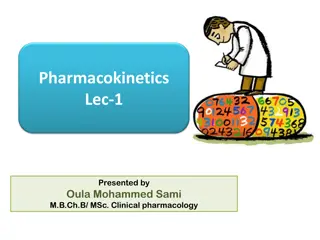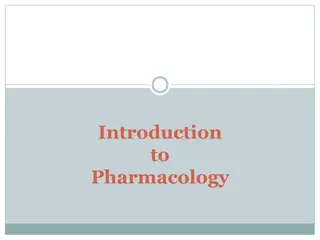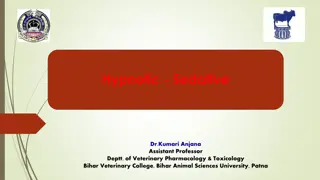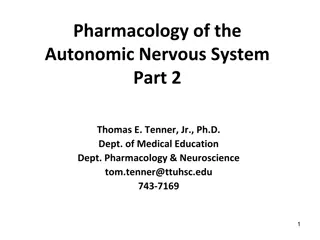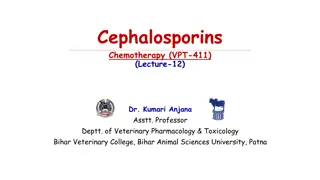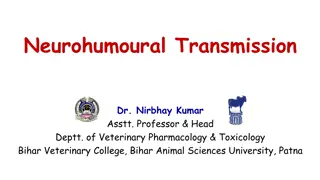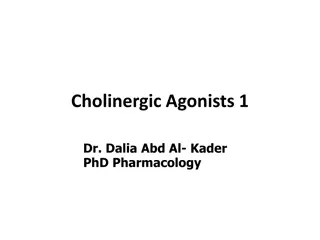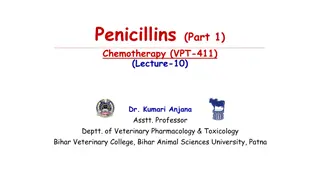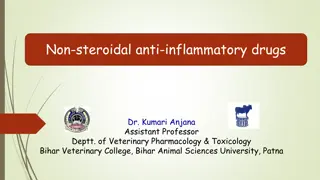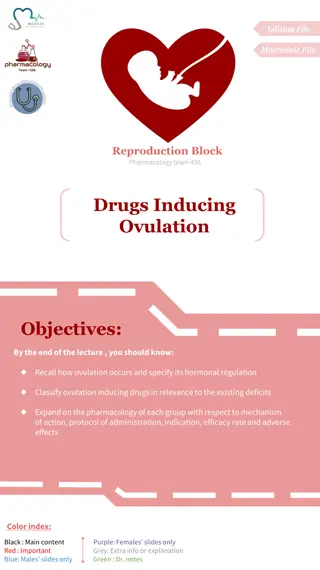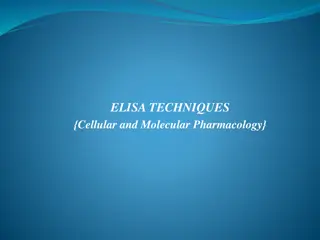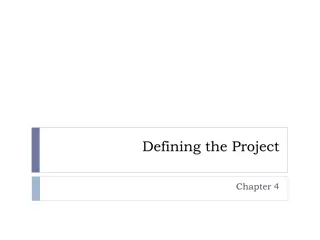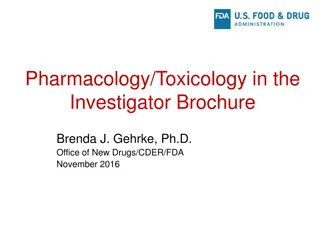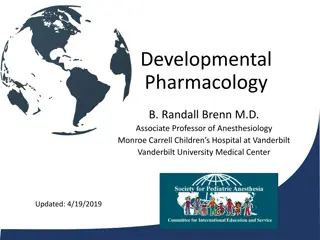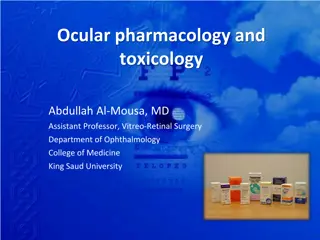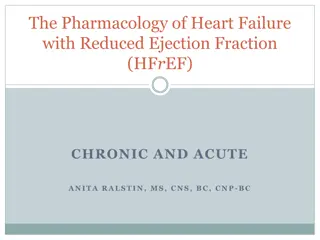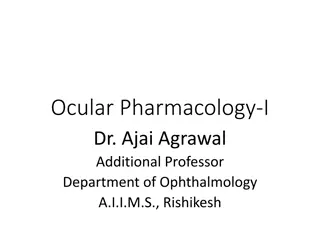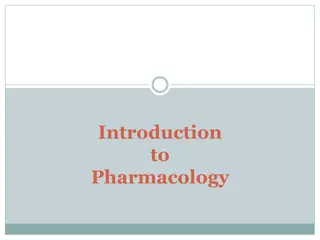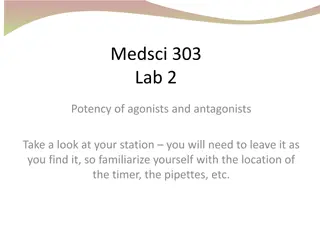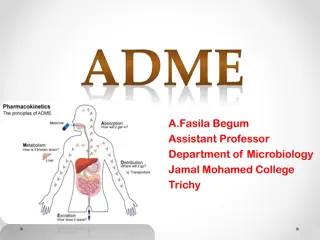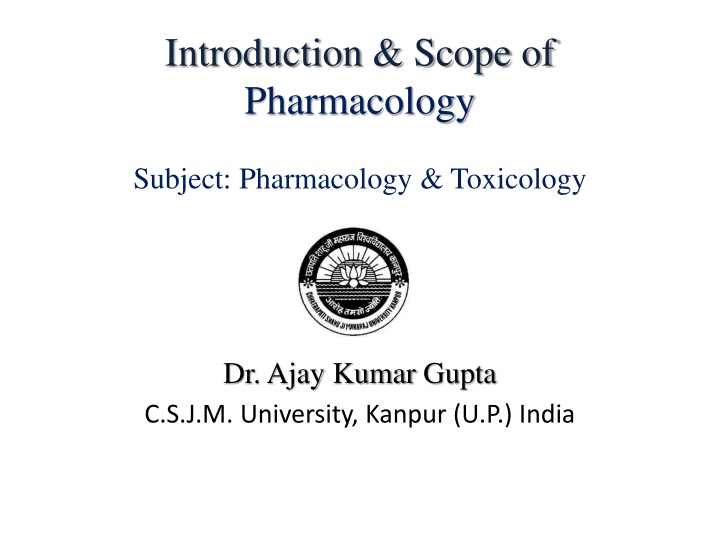
The Scope of Pharmacology and Toxicology
Delve into the fascinating world of pharmacology and toxicology with an overview of drug science, history, chemistry interactions, and more. Explore how drugs are developed, their effects on the body, and the pivotal role of pharmacokinetics and pharmacodynamics.
Download Presentation

Please find below an Image/Link to download the presentation.
The content on the website is provided AS IS for your information and personal use only. It may not be sold, licensed, or shared on other websites without obtaining consent from the author. If you encounter any issues during the download, it is possible that the publisher has removed the file from their server.
You are allowed to download the files provided on this website for personal or commercial use, subject to the condition that they are used lawfully. All files are the property of their respective owners.
The content on the website is provided AS IS for your information and personal use only. It may not be sold, licensed, or shared on other websites without obtaining consent from the author.
E N D
Presentation Transcript
Introduction & Scope of Pharmacology Subject: Pharmacology & Toxicology Dr. Ajay Kumar Gupta C.S.J.M. University, Kanpur (U.P.) India
Pharmacology Pharmacology is the science of drugs. The term Pharmacology is derived from Greek: Pharmacon drug; logos discourse in / the study of drug what they do and how they do it. Therefore, Pharmacology is the study of drugs or chemicals used to treat or cure a disease and their interactions in the body. Within the study of pharmacology there are a number of separate areas to consider, but for the nurses the most important aspects are pharmacokinetics (PK) and pharmacodynamics (PD). Two important and interrelated Pharmacodynamic. 1. Pharmacokinetics (Greek: Kinesis movement) What the body does to the drug. This refers to movement of the drug in and alteration of the drug by the body; absorption, distribution, metabolism and excretion (ADME). 2. Pharmacodynamics (Greek: dynamis power) What the drug does to the body. This includes physiological and biochemical effects of drugs and their mechanism of action at organ system/subcellular/macromolecular levels. areas are: Pharmacokinetics and
History of Modern Pharmacology It is of academic interest to know how drugs are discovered and developed. Often in the past, this was based on folklore or intelligent observation (e.g. digitalis leaf, penicillin). Nowadays, new drugs are mostly developed by the organic chemist working with a pharmacologist, increasingly from basic knowledge about key molecular targets. Usually some sort of biological screening is used to select an chemical molecule with optimum pharmacological activity. 1. Francois Magendie (1783-1855), a French physiologist laid down the dictum "Facts and facts alone are the basis of science." Experimental procedures with animals are the testing grounds for determination of drug action. 2. Claude Bernard (1813-1878), investigated the plant extract curare and proposed a site of action for this agent. 3. Rudolph Buchheim (1820-1879). In 1847 Buchheim established the first laboratory devoted to experimental pharmacology in the basement of his home in Dorpat which is known as the cradle of experimental pharmacology. 4. Oswald Schmiedeberg (1838-1921). In 1872 set up an institute of pharmacology in Strasbourg, France (Germany at that time) which became a Mecca for students who were interest in pharmacological problems. 5. J.N. Langley (1852-1925) and Sir Henry Dale (1875-1968) pioneered pharmacology in England, taking a physiological approach.
Chemistry & Pharmacology There is good interrelation between chemistry and pharmacology. The Chemical structures of drugs can provide information about mechanism of action, pharmacokinetics, stability, metabolic fate etc. Structure-Activity Relationship: A modification in a chemical structure of a drug may bring outs or diminish its pharmacological effects, often providing clues as to the mechanism of action. Apicture of the biological reactive site (i.e. receptor) could be developed in such studies. Also, drugs metabolized by body systems, which may convert the parent drug to a more active or a less active form. The chemical structure could be modified to enhance or diminish the rate of metabolic conversion. Sites ofAction: The organ or cellular target of drug action. Drug Receptors: Macromolecules in cells or cell membranes with which drugs interact to exert their effects. Usually the interacting forces are reversible ionic and Van der Waals bonds of relatively low energy, but sometimes covalent bonds are also formed (e.g. organophosphates).
Clinical Pharmacology and Therapeutics Indications: Clinical Pharmacology, deals with the pharmacological effects of drugs in man. It provides information about the usefulness, potency and toxicity of new drugs in humans. It is of great importance for the effective and safe use of drugs in man; i.e. the therapeutic use of drugs for the treatment of disease. There are specific clinic disorders or disease entities for which a given drug may be prescribed and the physician must weigh the potential benefit of drug use against the risks of adverse effects. Therapeutics: (Greek-therapeutike, means Medical Practice) Therapeutics is the practical branch of medicine dealing with the science and art of the treatment of disease. Empirical therapeutics is therapy bases on clinical evidence that the drug is effective, although the mechanism by which it act is unknown. Pharmacotherapeutics is the treatment of disease by means of drugs. It utilizes information on drugs obtained by pharmacodynamic studies. Contraindications and Factors may Modify Drug Action (e.g., liver disease: as detoxification of the drug by the liver is important) It is important to know that the presence of disease or organ pathology may influence the actions of a drug. Conditions such as age, pregnancy, concomitant administration of other drugs and disease may alter the patient's response to a given drug.
Bioavailability: The fraction of drug administered which is actually absorbed and reaches the systemic circulation following oral dosing. Preparations of the same drug by different manufacturers may have a different bioavailability. Toxicology Toxicology (Greek-toxikon means poison), it deals with the adverse effects of chemical/physical/ exogenous agents on biological system. Toxicology is the science of poisons, their sources, chemical composition, action, tests for detection and antidotes. It forms a major part of forensic and environmental medicine. All drugs are potential poisons when given in high doses. The term poison refers to agents that cause harmful effects Toxicology is concerned not only with drugs used in therapy but also with the other chemicals that may be responsible for household, environmental or industrial intoxication. Clinical toxicology deals with the detection, diagnosis and treatment of poisoning. Toxicodynamics describes the harmful effects that a poison produces on the living organism. Toxicokinetics encompasses the absorption, distribution, biotransformation and elimination of the poison.
Pharmacovigilence The Pharmacovigilence mainly focuses on the effects of drugs on patient safety. Some examples of chemicals or drug-induced toxicities are given below:- Allergic reactions: The number of serious allergic reactions to drugs involving antigen-antibody reactions is low but when they occur the physician must have sufficient knowledge to manage these problems. Blood dyscrasias: These are very complications of drug therapy. They include: agranulocytosis, aplastic anemia, hemolytic anemia, thrombocytopenia and defects in clotting factors. Hepatotoxicity and nephrotoxicity: Because many chemicals and drugs are eliminated and metabolized by the liver and kidney, damage to these organs is seen commonly Chemotherapy According to the definition proposed by Paul Ehrlich, deals with the use of drugs capable of inhibiting or destroying invading microbes, parasites, or cancer cells, while having minimal effect on recipient s healthy living tissues. serious and sometimes fatal

